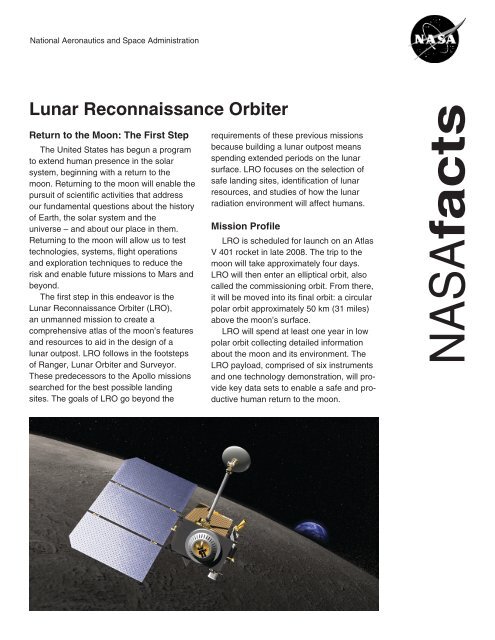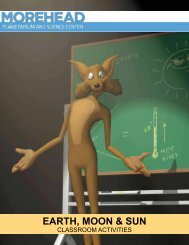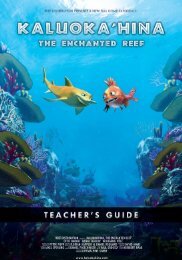LRO Fact Sheet - Lunar Reconnaissance Orbiter Camera
LRO Fact Sheet - Lunar Reconnaissance Orbiter Camera
LRO Fact Sheet - Lunar Reconnaissance Orbiter Camera
- No tags were found...
Create successful ePaper yourself
Turn your PDF publications into a flip-book with our unique Google optimized e-Paper software.
National Aeronautics and Space Administration<br />
<strong>Lunar</strong> <strong>Reconnaissance</strong> <strong>Orbiter</strong><br />
Return to the Moon: The First Step<br />
The United States has begun a program<br />
to extend human presence in the solar<br />
system, beginning with a return to the<br />
moon. Returning to the moon will enable the<br />
pursuit of scientific activities that address<br />
our fundamental questions about the history<br />
of Earth, the solar system and the<br />
universe – and about our place in them.<br />
Returning to the moon will allow us to test<br />
technologies, systems, flight operations<br />
and exploration techniques to reduce the<br />
risk and enable future missions to Mars and<br />
beyond.<br />
The first step in this endeavor is the<br />
<strong>Lunar</strong> <strong>Reconnaissance</strong> <strong>Orbiter</strong> (<strong>LRO</strong>),<br />
an unmanned mission to create a<br />
comprehensive atlas of the moon’s features<br />
and resources to aid in the design of a<br />
lunar outpost. <strong>LRO</strong> follows in the footsteps<br />
of Ranger, <strong>Lunar</strong> <strong>Orbiter</strong> and Surveyor.<br />
These predecessors to the Apollo missions<br />
searched for the best possible landing<br />
sites. The goals of <strong>LRO</strong> go beyond the<br />
requirements of these previous missions<br />
because building a lunar outpost means<br />
spending extended periods on the lunar<br />
surface. <strong>LRO</strong> focuses on the selection of<br />
safe landing sites, identification of lunar<br />
resources, and studies of how the lunar<br />
radiation environment will affect humans.<br />
Mission Profile<br />
<strong>LRO</strong> is scheduled for launch on an Atlas<br />
V 401 rocket in late 2008. The trip to the<br />
moon will take approximately four days.<br />
<strong>LRO</strong> will then enter an elliptical orbit, also<br />
called the commissioning orbit. From there,<br />
it will be moved into its final orbit: a circular<br />
polar orbit approximately 50 km (31 miles)<br />
above the moon’s surface.<br />
<strong>LRO</strong> will spend at least one year in low<br />
polar orbit collecting detailed information<br />
about the moon and its environment. The<br />
<strong>LRO</strong> payload, comprised of six instruments<br />
and one technology demonstration, will provide<br />
key data sets to enable a safe and productive<br />
human return to the moon.<br />
NASAfacts
Instrument Payload<br />
Cosmic Ray Telescope for the Effects of Radiation<br />
The Cosmic Ray Telescope for the Effects of<br />
Radiation (CRaTER) will characterize the lunar radiation<br />
environment allowing scientists to determine potential<br />
biological impacts. CRaTER will also test models of<br />
radiation effects and shielding and measure radiation<br />
absorption by human tissue-like plastic, aiding in the<br />
development of protective technologies to help keep<br />
crews safe.<br />
Diviner <strong>Lunar</strong> Radiometer Experiment<br />
The Diviner <strong>Lunar</strong> Radiometer (DLRE) will measure<br />
surface and subsurface temperatures from orbit. It will<br />
identify cold traps and potential ice deposits as well as<br />
rough terrain, rock abundance and other landing<br />
hazards.<br />
Lyman Alpha Mapping Project<br />
The Lyman Alpha Mapping Project (LAMP) will map<br />
the entire lunar surface in the far ultraviolet spectrum.<br />
LAMP will search for surface ice and frost in the polar<br />
regions and provide images of permanently shadowed<br />
regions illuminated only by starlight and the glow of<br />
interplanetary hydrogen emission, the Lyman Alpha<br />
line.<br />
<strong>Lunar</strong> Exploration Neutron Detector<br />
The <strong>Lunar</strong> Exploration Neutron Detector (LEND)<br />
will create high-resolution maps of hydrogen distribution<br />
and gather information about the neutron component<br />
of lunar radiation environment. LEND data will be<br />
analyzed to search for evidence of water ice near the<br />
moon’s surface.<br />
<strong>Lunar</strong> <strong>Orbiter</strong> Laser Altimeter<br />
The <strong>Lunar</strong> <strong>Orbiter</strong> Laser Altimeter (LOLA) will measure<br />
landing site slopes, lunar surface roughness, and<br />
generate a high resolution 3-dimensional map of the<br />
moon. LOLA also will measure and analyze the lunar<br />
topography to identify the permanently illuminated and<br />
permanently shadowed areas.<br />
<strong>Lunar</strong> <strong>Reconnaissance</strong> <strong>Orbiter</strong> <strong>Camera</strong><br />
Two narrow angle cameras (NACs) on the <strong>Lunar</strong><br />
<strong>Reconnaissance</strong> <strong>Orbiter</strong> <strong>Camera</strong> (<strong>LRO</strong>C) will make high<br />
resolution black-and-white images of the surface, capturing<br />
images of the poles with resolutions down to 1 m<br />
(3.3 feet). Up to 10% of the lunar surface will be imaged<br />
with the NACs. A third, wide angle camera (WAC),<br />
will take color and ultraviolet images over the complete<br />
lunar surface at 100 m resolution. These images<br />
will show polar lighting conditions, identify potential<br />
resources and hazards, and aid selection of safe landing<br />
sites.<br />
Mini-RF Technology Demonstration<br />
The Miniature Radio Frequency Technology<br />
Demonstration (Mini-RF) is an advanced synthetic aperture<br />
radar that operates in both the X and S bands of<br />
the radio spectrum. It will be used to image the polar<br />
regions and search for water ice. In addition, it will<br />
used to demonstrate the ability to communicate with an<br />
Earth-based ground station.<br />
Data Return<br />
With a comprehensive data set focused on supporting<br />
the extension of human presence in the solar<br />
system, the <strong>Lunar</strong> <strong>Reconnaissance</strong> <strong>Orbiter</strong> will help<br />
identify sites that are close to potential resources and<br />
have high scientific value, favorable terrain, and the<br />
environment necessary for safe future robotic and<br />
human lunar missions. All initial data sets will be deposited<br />
in the Planetary Data System, a publicly accessible<br />
repository of planetary science information, within six<br />
months of primary mission completion. The processed<br />
data sets will provide a deeper understanding of the<br />
moon and its environment. This will clear the way for a<br />
safe human return to the moon and for future human<br />
exploration of our solar system.<br />
For additional information on <strong>LRO</strong>, visit:<br />
http://lro.gsfc.nasa.gov<br />
National Aeronautics and Space Administration<br />
Goddard Space Flight Center<br />
Street Address<br />
Greenbelt, MD 20771<br />
www.nasa.gov<br />
NASA <strong>Fact</strong>s<br />
FS-2007-11-098-GSFC





